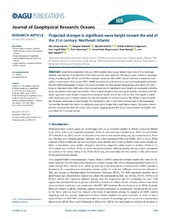| dc.contributor.author | Aarnes, Ole Johan | |
| dc.contributor.author | Reistad, Magnar | |
| dc.contributor.author | Breivik, Øyvind | |
| dc.contributor.author | Bitner-Gregersen, Elzbieta M. | |
| dc.contributor.author | Eide, Lars Ingolf | |
| dc.contributor.author | Gramstad, Odin | |
| dc.contributor.author | Magnusson, Anne Karin | |
| dc.contributor.author | Natvig, Bent | |
| dc.contributor.author | Vanem, Erik | |
| dc.date.accessioned | 2018-03-16T13:52:33Z | |
| dc.date.available | 2018-03-16T13:52:33Z | |
| dc.date.issued | 2017-04 | |
| dc.Published | Aarnes OJ, Reistad M, Breivik Ø, Bitner-Gregersen EM, Eide LI, Gramstad O, Magnusson AK, Natvig B, Vanem E. Projected changes in significant wave height toward the end of the 21st century: Northeast Atlantic. Journal of Geophysical Research - Oceans. 2017;122(4):3394-3403 | eng |
| dc.identifier.issn | 2169-9291 | en_US |
| dc.identifier.issn | 2169-9275 | en_US |
| dc.identifier.uri | https://hdl.handle.net/1956/17524 | |
| dc.description.abstract | Wind field ensembles from six CMIP5 models force wave model time slices of the northeast Atlantic over the last three decades of the 20th and the 21st centuries. The future wave climate is investigated by considering the RCP4.5 and RCP8.5 emission scenarios. The CMIP5 model selection is based on their ability to reconstruct the present (1971–2000) extratropical cyclone activity, but increased spatial resolution has also been emphasized. In total, the study comprises 35 wave model integrations, each about 30 years long, in total more than 1000 years. Here annual statistics of significant wave height are analyzed, including mean parameters and upper percentiles. There is general agreement among all models considered that the mean significant wave height is expected to decrease by the end of the 21st century. This signal is statistically significant also for higher percentiles, but less evident for annual maxima. The RCP8.5 scenario yields the strongest reduction in wave height. The exception to this is the north western part of the Norwegian Sea and the Barents Sea, where receding ice cover gives longer fetch and higher waves. The upper percentiles are reduced less than the mean wave height, suggesting that the future wave climate has higher variance than the historical period. | en_US |
| dc.language.iso | eng | eng |
| dc.publisher | American Geophysical Union | en_US |
| dc.title | Projected changes in significant wave height toward the end of the 21st century: Northeast Atlantic | en_US |
| dc.type | Peer reviewed | |
| dc.type | Journal article | |
| dc.date.updated | 2018-02-08T13:50:33Z | |
| dc.description.version | publishedVersion | en_US |
| dc.rights.holder | Copyright 2017. American Geophysical Union. All Rights Reserved. | en_US |
| dc.identifier.doi | https://doi.org/10.1002/2016jc012521 | |
| dc.identifier.cristin | 1469791 | |
| dc.source.journal | Journal of Geophysical Research - Oceans | |
| dc.relation.project | Norges forskningsråd: 226239 (ExWaCli), 256466 (ExWaMar) | |
